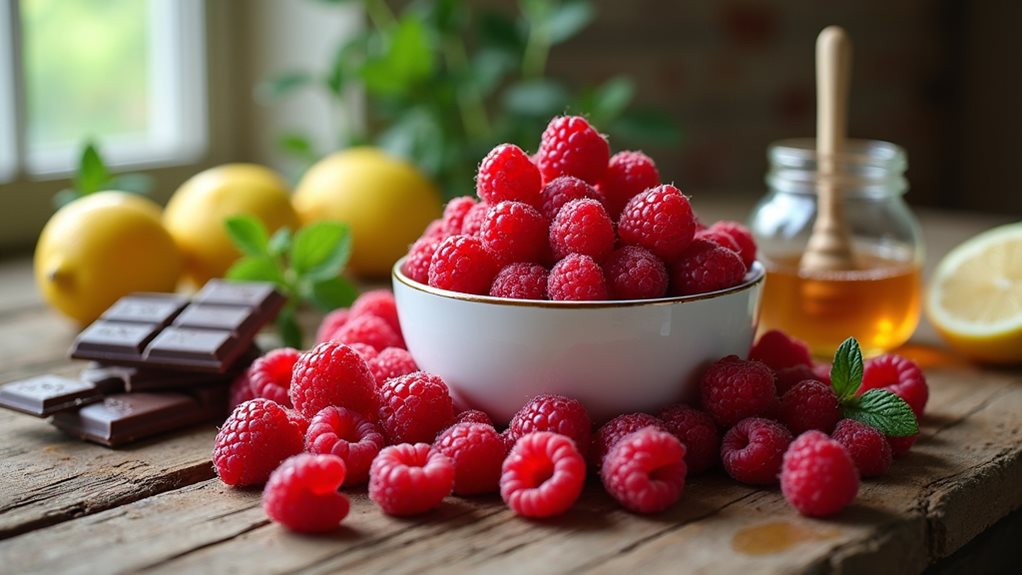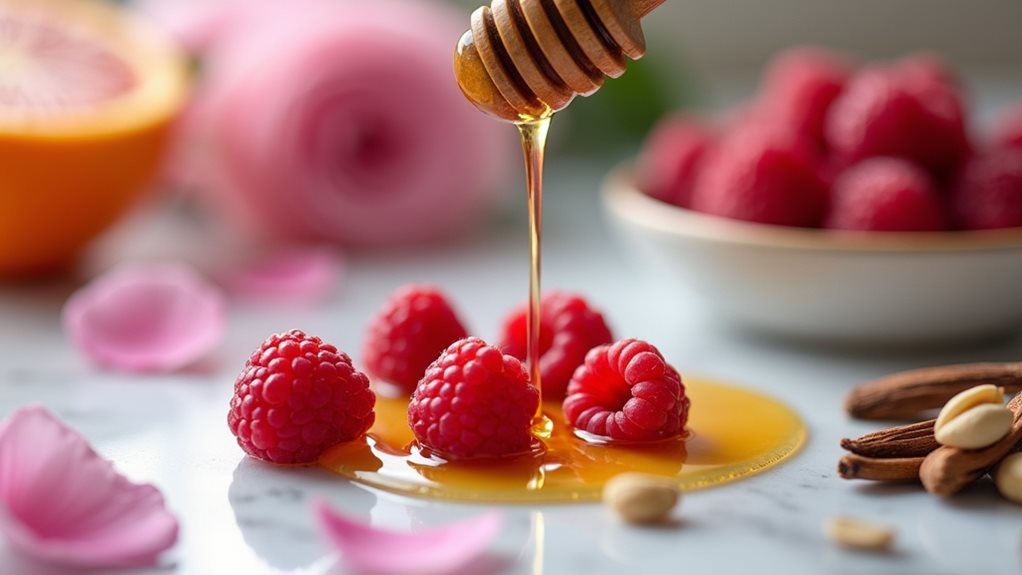Rhubarb's distinct tartness pairs beautifully with complementary flavors to create culinary magic in your kitchen. You'll find it shines alongside strawberries, raspberries, and orange for natural sweetness, while herbs like mint, rosemary, and tarragon add aromatic complexity. Warming spices such as cinnamon, ginger, and cardamom balance its acidity perfectly. Don't limit yourself to desserts—rhubarb works surprisingly well with savory dishes featuring pork or goat cheese. Explore these versatile combinations to reveal rhubarb's full potential.
The Sweet and Tangy World of Rhubarb
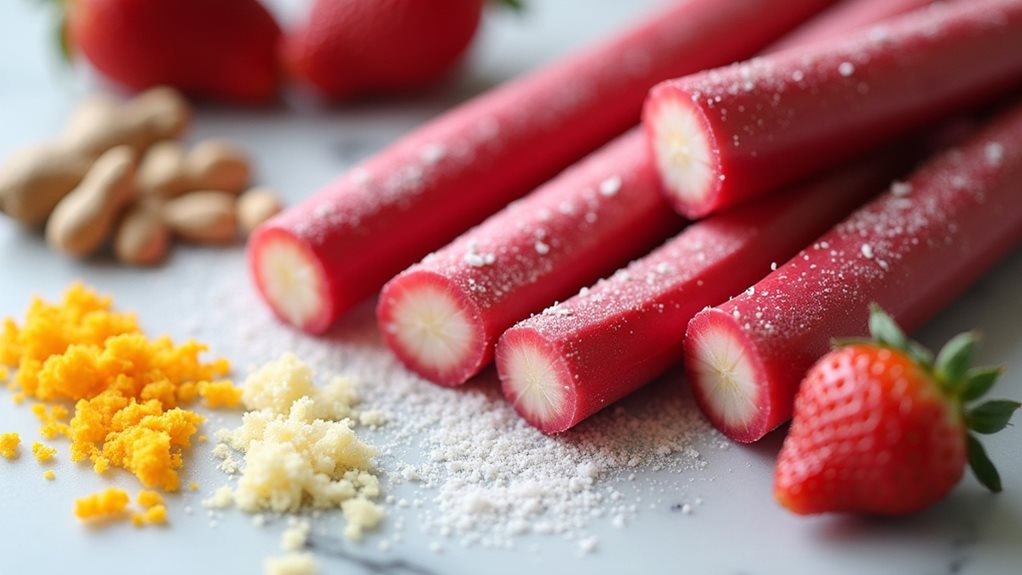
Rhubarb, with its distinctive crimson stalks and mouth-puckering tartness, offers an exciting canvas for culinary exploration.
You'll find this versatile ingredient transforms dramatically when paired with complementary flavors that balance its natural acidity. While brown sugar and honey are classic sweeteners, don't overlook the depth that spices like cinnamon and ginger can add to your creations.
Understanding rhubarb preservation techniques allows you to enjoy its unique profile year-round—try pickling, freezing, or transforming it into jams and compotes.
Beyond its culinary applications, rhubarb nutrition benefits include high fiber content, vitamin K, and calcium. For those looking to explore rhubarb in beverages, its tartness creates a perfect match with juniper and botanicals found in quality gins.
When working with rhubarb, remember that its tartness creates wonderful contrasts with rich dairy, sweet fruits, and even savory proteins like pork and salmon. A delicate addition of rose water to stewed rhubarb brings an elegant floral dimension to breakfast dishes served with yogurt and muesli.
Herbs That Elevate Rhubarb Dishes
While rhubarb's tartness is intrinsic to its charm, the right herb pairings can transform this vibrant vegetable into a culinary masterpiece. Mint offers a rejuvenating contrast in desserts and cocktails, while tarragon and chervil provide subtle anise notes that complement rhubarb's bold character.
Embrace rhubarb's natural tartness by selecting complementary herbs that elevate its distinctive profile into something truly extraordinary.
You'll find that rosemary and thyme, typically savory herbs, add surprising depth to both sweet and savory rhubarb applications. Our recipe demonstrates how parsley and mint can be beautifully sautéed with rhubarb to create a complex flavor profile. Raw preparations can showcase rhubarb's naturally tangy flavor profile that children and adults alike may discover enjoyable.
For more adventurous palates, experiment with herbal infusions like rose water or elderflower in desserts, or try juniper and spruce tips in cocktails for an evergreen dimension.
Don't overlook the potential of parsley in salads or lovage in dressings—these fresh, green notes balance rhubarb's acidity beautifully.
Even exotic pairings like sorrel or cinnamon basil can elevate your rhubarb creations to new heights.
Fruit Combinations That Shine With Rhubarb
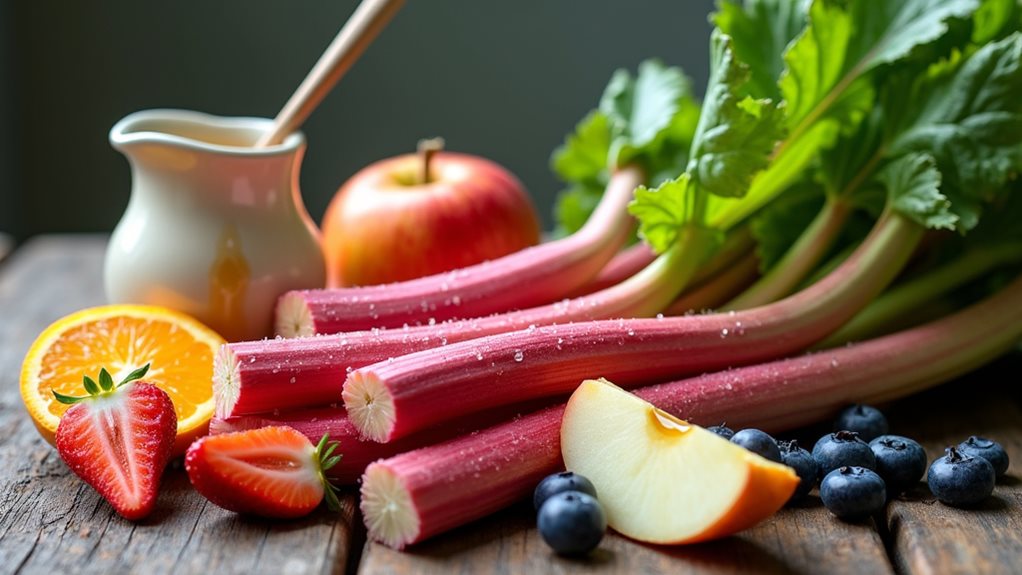
Beyond herbs, the fruit world offers countless exciting partners for rhubarb's distinctive tanginess. Strawberries remain the classic companion, creating a perfect balance between sweet and tart that works brilliantly in dessert toppings for ice cream or yogurt.
You'll find raspberries and blackberries offer complementary tartness while adding rich, fruity depth.
For unexpected combinations, try incorporating orange segments or lemon zest to brighten rhubarb's flavor profile in a revitalizing fruit salad.
Apple's natural sweetness creates harmonious balance in pies, while plums contrast tartness beautifully in jams. Rhubarb also pairs wonderfully with ginger, adding a warming spicy dimension to both sweet and savory dishes.
During warmer months, experiment with strawberry-raspberry-rhubarb crumbles for seasonal appeal. Rhubarb crumbles can be enhanced with crushed white chocolate in the topping for a delightful contrast to the fruit's acidity.
Don't overlook grapes or saskatoons, which can add natural sweetness without overwhelming rhubarb's character.
Each pairing transforms rhubarb's acidity into something truly remarkable.
Spices That Transform Rhubarb Recipes
Your rhubarb dishes will transform when you incorporate warming winter spices like cinnamon, ginger, and nutmeg, which balance the vegetable's natural tartness while adding depth and complexity.
For more adventurous palates, try bold exotic combinations such as garam masala, cardamom, or turmeric that elevate rhubarb beyond traditional dessert applications into exciting savory territory. The combination of tangy rhubarb with garam masala creates a unique flavor profile that works wonderfully in curries and stews. This versatility makes rhubarb compote an excellent pairing for pork dishes, adding a sweet-tart element that complements hearty meats.
When experimenting with spice intensity, remember that the goal is to balance tartness with heat—start with smaller amounts and adjust according to your preference, as too much spice can overwhelm rhubarb's distinctive tanginess.
Warming Winter Spice Blends
The magic of winter spice blends transforms ordinary rhubarb into extraordinary culinary creations that warm both body and soul during colder months.
When applying spice layering techniques, you'll discover how certain combinations enhance rhubarb's natural profile while taming its tartness.
Following seasonal spice trends, create your own signature blends that balance and complement rhubarb's unique flavor:
- Combine cinnamon and mace for a classic pairing that elevates baked desserts.
- Mix cardamom with nutmeg for a citrusy warmth that modernizes traditional recipes.
- Blend star anise and cloves sparingly for rich depth without overwhelming.
- Incorporate ginger and allspice for a balanced profile that enhances rhubarb's natural sweetness.
Winter blends like these don't just mask rhubarb's tartness—they transform it, creating complexity that makes cold-weather desserts infinitely more interesting and satisfying.
Remember to always remove the toxic leaves from rhubarb before incorporating it into any spiced dessert recipes.
For a floral twist that honors historical baking traditions, consider adding rose water to your rhubarb creations, echoing the practices of early American bakers until the 19th century.
Consider experimenting with lacto-fermentation techniques to introduce a tangy dimension that beautifully complements rhubarb's natural flavor profile.
Bold Exotic Flavor Combinations
Venturing into exotic flavor territories with rhubarb opens up culinary possibilities that many home cooks haven't explored.
Star anise delivers a licorice-like quality that transforms both sweet and savory rhubarb dishes, while cardamom provides an intriguing sweet-savory note that pairs beautifully with strawberries and pears in rhubarb compotes.
For truly bold flavor contrasts, consider exotic spice blends incorporating cloves to balance rhubarb's tartness in savory applications.
Cinnamon adds depth and warmth to desserts, while nutmeg enhances the complexity of crumbles and crisps.
You'll find that rose petal and rose water create particularly memorable combinations with rhubarb, offering floral dimensions that elevate simple jams and sophisticated desserts alike.
Try pistachio with these floral-rhubarb pairings for a Middle Eastern-inspired flavor profile.
Balancing Tartness With Heat
While rhubarb's bold tartness can sometimes overwhelm the palate, strategic application of heat through carefully selected spices creates remarkable transformations in both sweet and savory recipes.
You'll find that proper heat techniques can mellow rhubarb's acidity while enhancing its complexity.
For successful tartness infusion, consider these approaches:
- Combine warming spices like cinnamon, ginger, and cloves to create depth without masking rhubarb's character.
- Experiment with Chinese five-spice for a multi-dimensional flavor profile.
- Introduce anise seeds for a subtle licorice note that elevates rhubarb's natural properties.
- Incorporate fresh ginger when quick-cooking rhubarb to maintain brightness while adding warmth.
When using spices with rhubarb, start conservatively—you can add more, but can't remove excess once incorporated.
Unexpected Savory Pairings for Rhubarb
Despite its common association with sweet desserts, rhubarb's distinctive tartness creates surprisingly harmonious relationships with savory ingredients. You'll find this versatile vegetable elevates meat dishes wonderfully—try pairing it with pork chops, lamb stew, or beef for an unexpected flavor contrast that balances richness with acidity.
Savory rhubarb applications extend beyond meat pairings. Consider incorporating it into soups like rhubarb-tomato or leek varieties, where its tangy profile adds complexity.
You can also explore unexpected pairings with dairy products—goat cheese crostini topped with rhubarb chutney offers an impressive appetizer, while aged cheddar tempers rhubarb's sharpness beautifully. Much like the earthy roasted beets that complement creamy goat cheese in a classic salad, rhubarb's bright acidity creates a perfect counterpoint to rich dairy flavors.
For a creative twist, pickle rhubarb to add bursts of flavor to various dishes or transform traditional barbecue sauce into "rhubarbecue" for grilled meats.
Creative Beverage Applications for Rhubarb
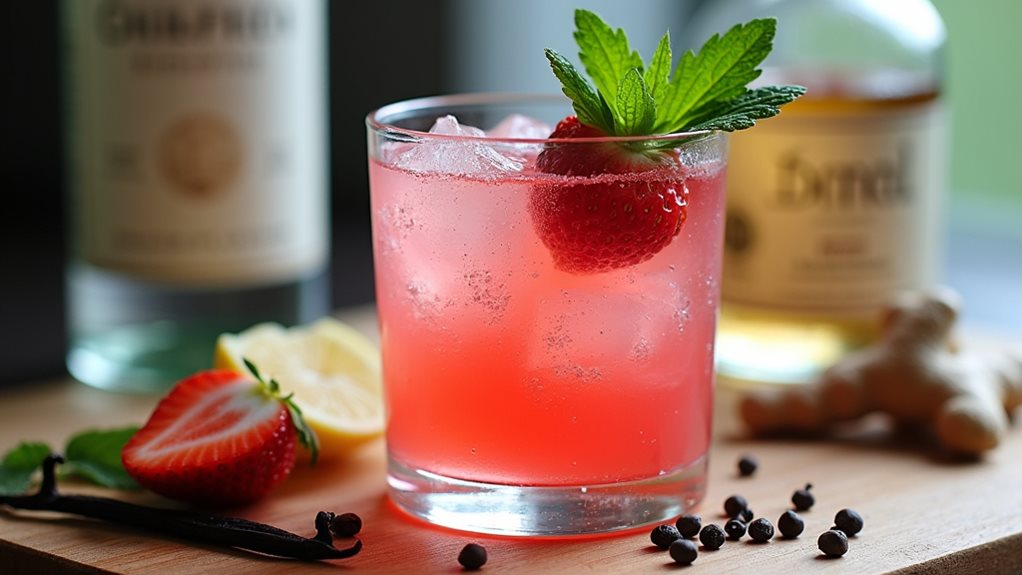
Rhubarb's tart profile transforms ordinary beverages into extraordinary drinking experiences, extending far beyond its traditional role in pies and desserts.
Its vibrant color and distinctive flavor create stunning rhubarb cocktails and mocktails that will impress even the most discerning guests.
Try incorporating rhubarb into your beverage repertoire with these versatile applications:
- Create a homemade rhubarb shrub by combining rhubarb syrup with vinegar for a complex base that enhances both alcoholic and non-alcoholic drinks.
- Infuse rhubarb syrup with herbs like rosemary or basil to add depth to gin-based cocktails.
- Pair rhubarb with prosecco or champagne for effervescent spring celebrations.
- Balance rhubarb's tartness with ginger beer in invigorating mocktails like the rhubarb blueberry basil.
You'll find rhubarb pairs exceptionally well with botanical gins and citrus, creating sophisticated flavor profiles that highlight its unique character.
Frequently Asked Questions
Is Rhubarb Safe to Eat Raw?
Yes, you can safely eat raw rhubarb stalks, though they're quite tart. You'll find raw rhubarb benefits in salads and quick recipes. Try dipping in honey or blending into innovative raw rhubarb recipes for maximum enjoyment.
How Do I Prevent My Rhubarb From Becoming Too Stringy?
Why suffer through fibrous stalks? Prevent stringy texture by harvesting young, tender stems, ensuring proper division every 4-5 years, and using appropriate cooking methods like peeling tough outer fibers before preparation. You'll revolutionize your rhubarb experience!
Can You Freeze Rhubarb for Later Use?
Yes, you can freeze rhubarb! Simply wash, dry, and cut stalks, then freeze using three methods: blanching, sugar syrup, or direct freezing. This innovative preserving rhubarb technique extends your harvest year-round. No thawing needed for cooking!
What Parts of the Rhubarb Plant Are Toxic?
Only the leaves of rhubarb contain toxic compounds like oxalic acid and anthraquinone glycosides. You'll want to stick with the stalks for safe consumption—they're the only part you should eat.
How Do I Balance Rhubarb's Tartness Without Excessive Sugar?
You can balance rhubarb's tartness with honey, maple syrup, or agave as alternatives to sugar. Try pairing with dairy, citrus zest, warming spices, or naturally sweet fruits like strawberries for innovative flavor enhancement techniques.
Final Thoughts
You're now armed with rhubarb pairing knowledge that'll make your grandmother's classic strawberry-rhubarb pie look positively pedestrian. While your dinner guests nod politely at your dissertation on "complementary flavor compounds," they're secretly wondering if anyone actually needed seventeen different ways to prepare a vegetable that's fundamentally celery's more dramatic cousin. Go forth and experiment—your Instagram feed awaits these crimson culinary adventures!


